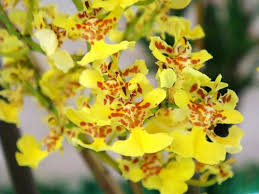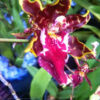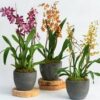# How to Identify When Oncidium Orchids Are Ready to Bloom

Oncidium orchids, commonly known as “Dancing Lady Orchids,” are prized for their vibrant and intricate blooms that can transform any space into a floral paradise. One of the most exciting aspects of growing Oncidium orchids is anticipating their flowering stage. Understanding when your orchids are ready to bloom requires careful observation and knowledge of their growth patterns. In this comprehensive guide, we will explore the signs that indicate your Oncidium orchids are prepared to produce flowers, as well as tips on how to care for them during this critical period.
## 1. Understanding Oncidium Orchids
### 1.1 General Characteristics
Before delving into the specific signs of impending blooms, it’s essential to understand the unique characteristics of Oncidium orchids:
– **Family**: Oncidium orchids belong to the Orchidaceae family, which encompasses a vast range of species and hybrids.
– **Growth Habit**: These orchids can grow as epiphytes, which means they thrive on other plants, or as lithophytes, where they grow on rocks. Some varieties can also grow in the soil as terrestrial plants.
– **Flower Appearance**: Oncidium flowers are known for their beautiful shapes and bright colors, often resembling little dancing figures. The blooms can come in shades of yellow, brown, red, and white, often adorned with spots and patterns.
### 1.2 Blooming Cycle
Oncidium orchids typically bloom once or twice a year, depending on the specific species and environmental conditions. The blooming cycle can be influenced by factors such as temperature, light, and humidity. Understanding their blooming cycle is crucial for recognizing when they are about to flower.
## 2. Key Signs of Imminent Blooming
### 2.1 Healthy Pseudobulbs
One of the first indicators that an Oncidium orchid is ready to bloom is the development of healthy pseudobulbs:
– **Pseudobulb Characteristics**: Pseudobulbs are swollen stems that store water and nutrients. Healthy pseudobulbs should be firm and plump. If they appear shriveled or dry, it may indicate that the plant is under stress.
– **Observation**: Monitor the growth of pseudobulbs; when you see new ones forming, it’s a good sign that your orchid is healthy and may be preparing to bloom.
### 2.2 New Growth and Leaf Development
Another critical sign that your Oncidium orchid is nearing its blooming stage is the emergence of new growth and leaves:
– **New Shoots**: Watch for new shoots developing from the base of the plant or from the pseudobulbs. These shoots often signify that the plant is entering a growth phase that can lead to flowering.
– **Leaf Maturity**: Ensure that the new leaves are healthy and fully developed. Robust leaves are essential for photosynthesis and energy production, which support the flowering process.
### 2.3 Flower Spike Formation
The formation of flower spikes (inflorescences) is the most apparent sign that your Oncidium orchid is about to bloom:
– **Spike Emergence**: Flower spikes typically emerge from the base of the plant or between the leaves. They can appear as long stems with buds developing along them.
– **Bud Development**: Once the spikes appear, it’s crucial to monitor their development. As the buds grow, they will start to swell and change color, signaling that they are maturing.
## 3. Environmental Conditions for Blooming
### 3.1 Light Requirements
Light is one of the most critical factors influencing blooming in Oncidium orchids:
– **Light Intensity**: Oncidium orchids thrive in bright, indirect light. Insufficient light can delay blooming, while excessive direct sunlight can cause leaf burn.
– **Observation**: Ensure that your orchids receive around 10-12 hours of light daily. Use shade cloths or diffusers to filter strong sunlight if necessary.
### 3.2 Temperature Fluctuations
Temperature plays a significant role in triggering the blooming process:
– **Day and Night Temperature**: Oncidium orchids prefer daytime temperatures between 65°F and 80°F (18°C to 27°C) and slightly cooler at night. A temperature drop of 10-15°F (5-8°C) at night can help stimulate blooming.
– **Seasonal Changes**: Fall is often the time when many Oncidium orchids naturally prepare for blooming. Monitor temperature changes with the seasons to support this process.
### 3.3 Humidity Levels
High humidity levels are essential for the health of Oncidium orchids:
– **Ideal Humidity**: These orchids thrive in humidity levels between 50% and 70%. Insufficient humidity can lead to stress and delay flowering.
– **Humidity Control**: Use humidifiers, misting, or humidity trays to maintain optimal humidity levels, especially during dry seasons.
## 4. Nutritional Needs for Blooming
### 4.1 Fertilization Practices
Proper fertilization is crucial for preparing Oncidium orchids for blooming:
– **Balanced Fertilizer**: Use a balanced orchid fertilizer with a ratio such as 20-20-20 or a high-phosphorus formula (like 15-30-15) during the growing season to encourage flower development.
– **Fertilization Schedule**: Fertilize every two weeks during the growing season, and reduce the frequency during dormancy. Avoid over-fertilizing, which can harm the plant.
### 4.2 Timing of Nutrient Boosts
Timing is essential when it comes to fertilization:
– **Before Blooming**: A nutrient boost just before the blooming period can help promote flower formation. Ensure that the plants are well-fed during the active growth phase leading up to blooming.
## 5. Watering Techniques
### 5.1 Understanding Watering Needs
Proper watering practices are critical for the overall health of Oncidium orchids:
– **Frequency**: Water your orchids when the top inch of the growing medium feels dry. Overwatering can lead to root rot, while underwatering can cause dehydration.
– **Water Quality**: Use distilled or rainwater to avoid the harmful effects of chemicals in tap water.
### 5.2 Watering Methods
Implementing the right watering techniques can significantly impact blooming:
– **Soaking Method**: Consider soaking your orchids by placing the pots in a basin of water for about 15-30 minutes. This ensures thorough moisture penetration.
– **Draining**: Always allow the pots to drain completely after watering to prevent water from sitting at the bottom.
## 6. Monitoring for Pests and Diseases
### 6.1 Identifying Common Pests
Keeping your Oncidium orchids free from pests is vital for their health and blooming potential:
– **Common Pests**: Watch out for aphids, mealybugs, spider mites, and scale insects. These pests can cause significant damage to your orchids if left unchecked.
– **Signs of Infestation**: Look for sticky residue, webbing, or discolored leaves, which can indicate a pest problem.
### 6.2 Treatment Options
Implement pest management strategies to protect your orchids:
– **Natural Remedies**: Use insecticidal soap or neem oil to treat infestations. Regularly inspect your plants for early signs of pests.
– **Hygiene Practices**: Keep the growing area clean and free from debris to minimize pest habitats. Remove any dead or decaying leaves that may attract pests.
### 6.3 Disease Prevention
Preventing diseases is crucial for ensuring healthy blooms:
– **Good Air Circulation**: Ensure adequate airflow around your orchids to prevent fungal diseases. Avoid overcrowding plants in your growing area.
– **Avoid Overwatering**: Overwatering can lead to root rot and other moisture-related diseases. Follow proper watering practices to prevent these issues.
## 7. Patience During the Blooming Process
### 7.1 Timeframe for Blooming
Understanding the timeframe for blooming can help you gauge when to expect flowers:
– **Blooming Duration**: Oncidium orchids typically take several weeks to months to transition from bud to full bloom. Patience is key during this time.
– **Flower Lifespan**: Once blooming occurs, flowers can last several weeks to a few months, depending on the specific variety and environmental conditions.
### 7.2 Enjoying the Process
While waiting for your orchids to bloom, take the time to appreciate the growth process:
– **Observation**: Keep a close eye on your plants, noting any changes in growth, color, or overall health. This will enhance your understanding of their needs and help you adjust care practices as necessary.
– **Documentation**: Consider keeping a journal to track your orchids’ growth, flowering times, and care routines. This information can be invaluable for future blooming seasons.
## 8. Post-Blooming Care
### 8.1 Aftercare for Blooms
Once your Oncidium orchids have finished blooming, proper care is essential for maintaining their health:
– **Pruning**: Remove spent flower spikes by cutting them back to the base. This encourages new growth and prepares the plant for its next blooming cycle.
– **Adjusting Care**: After blooming, reduce watering and fertilization as the plant enters a resting phase. Monitor for new growth, indicating readiness for the next cycle.
### 8.2 Preparing for the Next Bloom
Encouraging subsequent blooms involves careful attention to care practices:
– **Re-evaluating Conditions**: After the blooming season, assess environmental conditions, and make necessary adjustments to light, temperature, and humidity.
– **Repotting**: If the plant has outgrown its pot or the growing medium has deteriorated, consider repotting to ensure continued health and vitality.
## Conclusion
Recognizing when your Oncidium orchids are ready to bloom is a rewarding experience that requires careful observation and
an understanding of their needs. By monitoring signs such as healthy pseudobulbs, new growth, flower spike formation, and environmental conditions, you can anticipate the stunning blooms that these orchids are known for. With the right care, patience, and attention to detail, your Oncidium orchids can flourish and bring beauty to your home or garden for years to come. Happy gardening!

